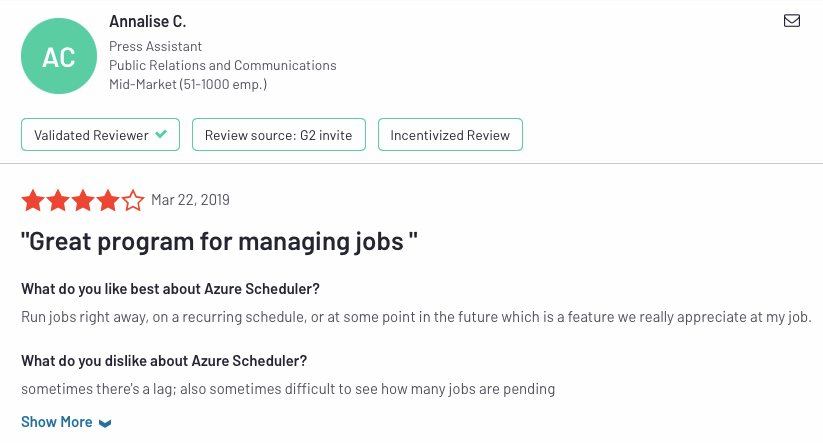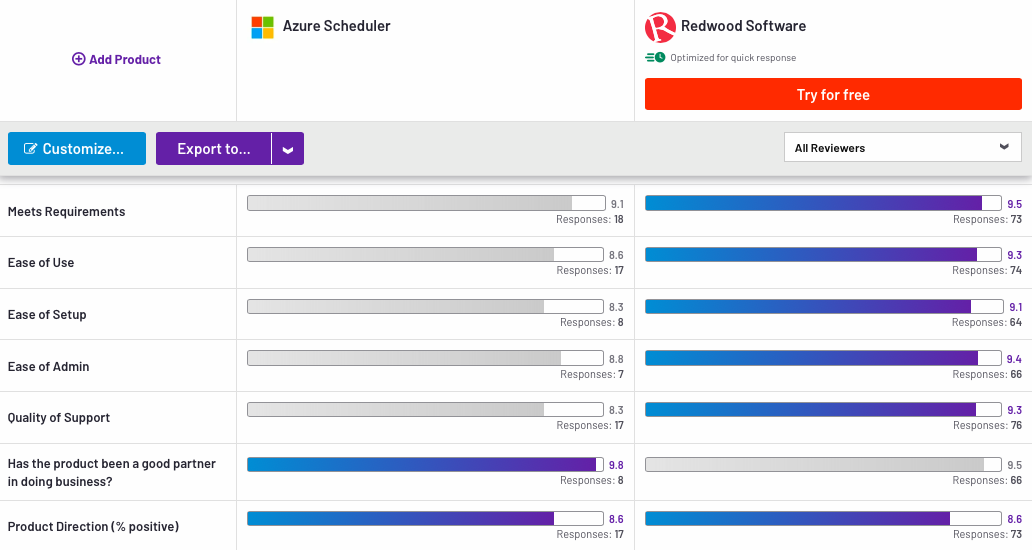[ad_1]
Job scheduling benefits include:
- Improved productivity and efficiency in process management
- Ensured proper sequencing and smooth execution of workflows
- Enhanced visibility and control over task execution and progress.
Azure scheduler is a cloud-based service from Microsoft that can offer these benefits by running jobs on a centralized, flexible and simple platform. However, it is not easy to decide whether to choose Azure scheduler since:
Such a complex landscape might slow down technology leaders’ decision-making to pick a solution. Therefore, this article will review Azure Scheduler and compare it against its alternatives.
Azure Scheduler Review
Azure scheduler has been replaced with Azure Logic Apps as the tool was retired in 2019. Logic Apps provide Scheduling functionality along with additional features like a built-in support for tracking, alerting, and logging. In our review and comparison, we evaluated both tools.

Pros:
- Ease of use: On G2, Azure Scheduler scores as 8.6 for ease of use. Also, a reviewer favorable comments about the easy interface of the tool (See Figure 1).
- Easy Integration: According to reviews, Azure scheduler provides an easy integration for different apps by 8.9, data by 8.6 and plugins by 7.8. 2
- Flexibility: Azure Scheduler supports various types of tasks, including HTTP requests, function invocations, and storage queue messages.

Cons:
- Dependency on Azure: Azure Scheduler is tightly coupled with the Azure platform, which means it may not be the ideal choice if you have a multi-cloud or hybrid environment that includes non-Azure components or services.
- Basic functionality: Azure Scheduler is primarily designed for basic scheduling and automation tasks. It may lack certain advanced features or capabilities that are available in more specialized job scheduling or workflow automation tools. For example, a reviewer mentions the difficulty to identify pending jobs (See Figure 2).
- Limited external integration: Azure scheduler may struggle with integration to external systems due to limitations.
- Lack of troubleshooting: Some reviewers mentioned the difficulty to troubleshoot the issues (See Figure 1). Azure Logic app users also complained about debugging and troubleshooting complex workflows (See Figure 3).

7 Azure scheduler alternatives
While deciding over Azure Scheduler alternatives, we have taken into account two factors:
- The number of B2B reviews: B2B reviews provide insights into the adoption rates of the tools and aid in gaining a better understanding of their strengths and weaknesses.
- The number of employees on LinkedIn: The employee count serves as an indicator of a firm’s revenue and overall success since a larger workforce can provide better support for company products and services. As a result, we excluded vendors whose LinkedIn profiles listed less than 10 employees.
The table below shows the total number of B2B reviews, average score that they obtain and ease of use score in descending order for B2B reviews:
| Solution | Ratings | Total number of reviews | Ease of Use |
|---|---|---|---|
| ActiveBatch | 4.5 | 259 | 8.7 |
| Redwood RunMyJobS | 4.7 | 174 | 9.3 |
| JAMS scheduler | 4.5 | 204 | 8.6 |
| Azure Logic Apps | 4.3 | 187 | 8.4 |
| Control-M | 4.1 | 159 | 8.8 |
| Azure Scheduler | 4.3 | 152 | 8.6 |
| VisualCron | 4.7 | 18 | 8 |
| Flux | 4.2 | 4 | NA |
| Robot Schedule | 4.5 | 1 | NA |
| Activeeon ProActive | 0 | 0 | NA |
If you prefer more comprehensive version of this comparison, you can:
Top 4 Azure scheduler alternatives
In our detailed comparison, we decided to focus on the market leaders. Therefore, we focused our comparison on top alternatives.
Number of B2B reviews are correlated with market shares and therefore we chose to focus on the top 4 Azure Scheduler alternatives that have accumulated over 100 reviews collectively across reputable review sources such as G2, Gartner, Trustradius, and Capterra.
1. ActiveBatch
ActiveBatch is a comprehensive workload automation and job scheduling platform that allows users to automate and manage complex business processes, workflows, and tasks across diverse systems and applications.

- Ease of use: ActiveBatch performs slightly better than Azure Scheduler considering the ease of use (See Figure 4).
- Quality of support: Reviewers score ActiveBatch higher than Azure Scheduler for quality of support they receive (See Figure 4).
- Integration: ActiveBatch integrates to various apps and systems and provides API integration.
2. Redwood RunMyJobs
Redwood RunMyJobs is a full-stack automation platform that can connect to various environments and applications.

- Ease of use: Redwood RunMyJobs have the highest score for ease of use among all Azure Scheduler alternatives (See Figure 5).
- Quality of support: Reviews indicate that Redwood delivers a higher quality of support than Azure Scheduler (See Figure 5).
3. Control-M
Control-M is a workload automation software that can automate and manage complex workflows across IT infrastructure.

- Ease of use: Control-M has a slightly higher ranking for the ease of use than Azure Scheduler (See Figure 6).
- Quality of support: Control-M obtains higher score than Azure Scheduler (See Figure 6).
Discover pros and cons of Control-M and compare it to Control-M alternatives.
4. JAMS Scheduler
JAMS is a job scheduling and workload automation software with native integration to various systems and applications, such as SAP.

- Ease of use: JAMS scheduler and Azure Scheduler receive the same average for ease of use. Yet, JAMS scheduler has a higher number of reviews. (See Figure 7).
- Quality of support: JAMS scheduler has the top quality of support score among all Azure scheduler alternatives (See Figure 7).
Learn more on JAMS Scheduler and its alternatives.
What are Azure scheduler alternatives on other cloud providers?
In the lists above, we focused exclusively on products that could replace Azure scheduler. However, if you are making a decision about your cloud platform and analyzing different cloud providers’ toolkits to aid your decision, you may want to know about tools that perform similar functions to Azure scheduler on other cloud providers.
These tools are:
- Amazon MQ: It is a fully managed message broker service offered by Amazon Web Services (AWS). Amazon MQ enables separate and reliable interaction and communication between various applications. It supports popular messaging protocols such as MQTT, AMQP, and STOMP, making it easy to integrate with various systems.
- Google Cloud Pub/Sub: It is a messaging and event-driven service provided by Google Cloud Platform (GCP). Google Cloud Pub/Sub allows users to build and integrate scalable communication between independent applications.
- IBM MQ: BM MQ, previously known as IBM WebSphere MQ, is a messaging middleware that facilitates the exchange of messages between various applications and systems.
- Red Hat AMQ: It is an enterprise-grade messaging platform that provides reliable and scalable messaging capabilities for distributed systems. It is based on popular open-source messaging technologies like Apache ActiveMQ and Apache Kafka, offering features such as message queuing, pub/sub patterns, and advanced message routing for seamless integration and communication within modern application architectures.
Transparency statement
AIMultiple serves numerous technology vendors, including Redwood which provides Active Batch, RunMyJobs, and Tidal.
Further reading
Compare other Workload automation and job scheduling tools and their alternatives:
If you need more help with listing, you can always:
Find the Right Vendors
- “Azure Scheduler User Reviews” G2. Revisited May 31, 2023.
- “Azure Scheduler User Reviews” G2. Revisited May 31, 2023.
- “Azure Scheduler User Reviews” G2. Revisited May 31, 2023.
- “Logic Apps User Reviews” G2. Revisited May 31, 2023.
- “Azure Scheduler vs. ActiveBatch” G2. Revisited May 31, 2023.
- “Azure Scheduler vs. Redwood” G2. Revisited May 31, 2023.
- “Azure Scheduler vs. Control-M” G2. Revisited May 31, 2023.
- “Azure Scheduler vs. JAMS” G2. Revisited May 31, 2023.
Source link

